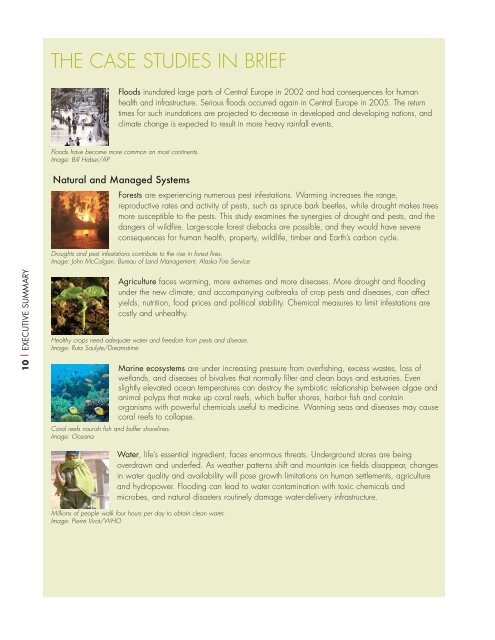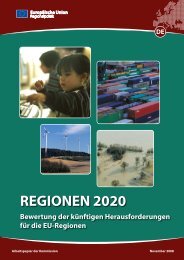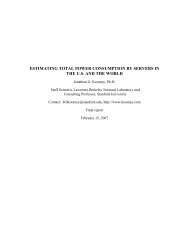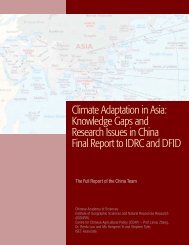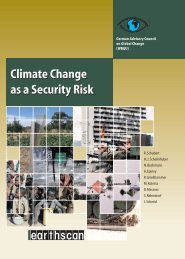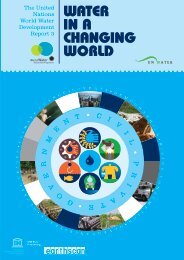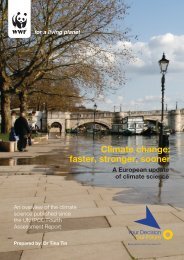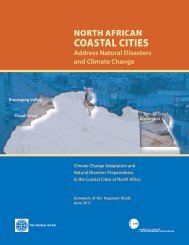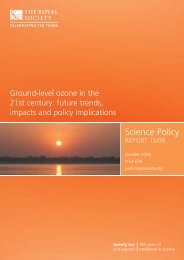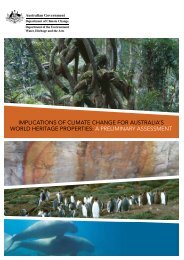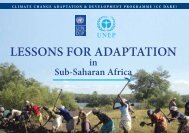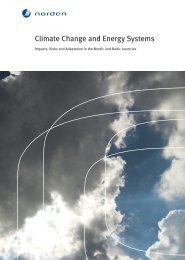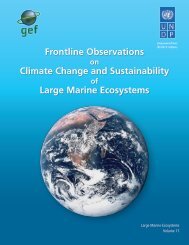Climate change futures: health, ecological and economic dimensions
Climate change futures: health, ecological and economic dimensions
Climate change futures: health, ecological and economic dimensions
Create successful ePaper yourself
Turn your PDF publications into a flip-book with our unique Google optimized e-Paper software.
THE CASE STUDIES IN BRIEFFloods inundated large parts of Central Europe in 2002 <strong>and</strong> had consequences for human<strong>health</strong> <strong>and</strong> infrastructure. Serious floods occurred again in Central Europe in 2005. The returntimes for such inundations are projected to decrease in developed <strong>and</strong> developing nations, <strong>and</strong>climate <strong>change</strong> is expected to result in more heavy rainfall events.Floods have become more common on most continents.Image: Bill Haber/APNatural <strong>and</strong> Managed SystemsForests are experiencing numerous pest infestations. Warming increases the range,reproductive rates <strong>and</strong> activity of pests, such as spruce bark beetles, while drought makes treesmore susceptible to the pests. This study examines the synergies of drought <strong>and</strong> pests, <strong>and</strong> thedangers of wildfire. Large-scale forest diebacks are possible, <strong>and</strong> they would have severeconsequences for human <strong>health</strong>, property, wildlife, timber <strong>and</strong> Earth’s carbon cycle.Droughts <strong>and</strong> pest infestations contribute to the rise in forest fires.Image: John McColgan, Bureau of L<strong>and</strong> Management, Alaska Fire Service10 | EXECUTIVE SUMMARYHealthy crops need adequate water <strong>and</strong> freedom from pests <strong>and</strong> disease.Image: Ruta Saulyte/DreamstimeCoral reefs nourish fish <strong>and</strong> buffer shorelines.Image: OceanaAgriculture faces warming, more extremes <strong>and</strong> more diseases. More drought <strong>and</strong> floodingunder the new climate, <strong>and</strong> accompanying outbreaks of crop pests <strong>and</strong> diseases, can affectyields, nutrition, food prices <strong>and</strong> political stability. Chemical measures to limit infestations arecostly <strong>and</strong> un<strong>health</strong>y.Marine ecosystems are under increasing pressure from overfishing, excess wastes, loss ofwetl<strong>and</strong>s, <strong>and</strong> diseases of bivalves that normally filter <strong>and</strong> clean bays <strong>and</strong> estuaries. Evenslightly elevated ocean temperatures can destroy the symbiotic relationship between algae <strong>and</strong>animal polyps that make up coral reefs, which buffer shores, harbor fish <strong>and</strong> containorganisms with powerful chemicals useful to medicine. Warming seas <strong>and</strong> diseases may causecoral reefs to collapse.Water, life’s essential ingredient, faces enormous threats. Underground stores are beingoverdrawn <strong>and</strong> underfed. As weather patterns shift <strong>and</strong> mountain ice fields disappear, <strong>change</strong>sin water quality <strong>and</strong> availability will pose growth limitations on human settlements, agriculture<strong>and</strong> hydropower. Flooding can lead to water contamination with toxic chemicals <strong>and</strong>microbes, <strong>and</strong> natural disasters routinely damage water-delivery infrastructure.Millions of people walk four hours per day to obtain clean water.Image: Pierre Virot/WHO


